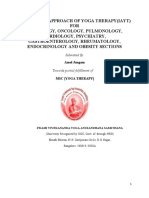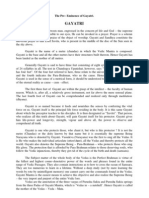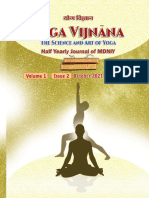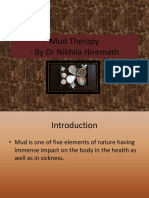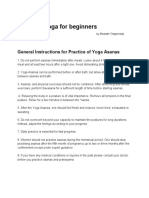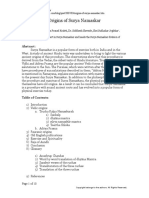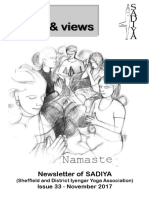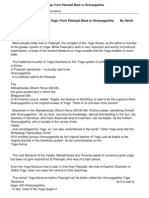0 ratings0% found this document useful (0 votes)
639 viewsAbhyasa Vairagya
Abhyasa Vairagya
Uploaded by
atulsahu24The document discusses the teachings of Maharishi Patanjali on Abhyasa (practice) and Vairagya (dispassion/non-attachment) from Patanjali's Yoga Sutras. It states that Patanjali and Lord Krishna in the Bhagavad Gita both taught that Abhyasa (regular yoga practice) and Vairagya (withdrawing the mind from external pleasures and consolidating mental energies) are needed to achieve yoga and still the mind. It defines Abhyasa as the discipline employed to remain in union with oneself, and Vairagya as withdrawing the mind from outer pleasures and controlling mental energies.
Copyright:
© All Rights Reserved
Available Formats
Download as PDF, TXT or read online from Scribd
Abhyasa Vairagya
Abhyasa Vairagya
Uploaded by
atulsahu240 ratings0% found this document useful (0 votes)
639 views6 pagesThe document discusses the teachings of Maharishi Patanjali on Abhyasa (practice) and Vairagya (dispassion/non-attachment) from Patanjali's Yoga Sutras. It states that Patanjali and Lord Krishna in the Bhagavad Gita both taught that Abhyasa (regular yoga practice) and Vairagya (withdrawing the mind from external pleasures and consolidating mental energies) are needed to achieve yoga and still the mind. It defines Abhyasa as the discipline employed to remain in union with oneself, and Vairagya as withdrawing the mind from outer pleasures and controlling mental energies.
Original Description:
Abhyasa Vairagya
Copyright
© © All Rights Reserved
Available Formats
PDF, TXT or read online from Scribd
Share this document
Did you find this document useful?
Is this content inappropriate?
The document discusses the teachings of Maharishi Patanjali on Abhyasa (practice) and Vairagya (dispassion/non-attachment) from Patanjali's Yoga Sutras. It states that Patanjali and Lord Krishna in the Bhagavad Gita both taught that Abhyasa (regular yoga practice) and Vairagya (withdrawing the mind from external pleasures and consolidating mental energies) are needed to achieve yoga and still the mind. It defines Abhyasa as the discipline employed to remain in union with oneself, and Vairagya as withdrawing the mind from outer pleasures and controlling mental energies.
Copyright:
© All Rights Reserved
Available Formats
Download as PDF, TXT or read online from Scribd
Download as pdf or txt
0 ratings0% found this document useful (0 votes)
639 views6 pagesAbhyasa Vairagya
Abhyasa Vairagya
Uploaded by
atulsahu24The document discusses the teachings of Maharishi Patanjali on Abhyasa (practice) and Vairagya (dispassion/non-attachment) from Patanjali's Yoga Sutras. It states that Patanjali and Lord Krishna in the Bhagavad Gita both taught that Abhyasa (regular yoga practice) and Vairagya (withdrawing the mind from external pleasures and consolidating mental energies) are needed to achieve yoga and still the mind. It defines Abhyasa as the discipline employed to remain in union with oneself, and Vairagya as withdrawing the mind from outer pleasures and controlling mental energies.
Copyright:
© All Rights Reserved
Available Formats
Download as PDF, TXT or read online from Scribd
Download as pdf or txt
You are on page 1of 6
Maharishi Patanjali
Abhyasa and Vairagya:
Practice and Centeredness
The two pillars of Yoga Sadhana
Shriram Sarvotham
Abhyasa and Vairagya: Practice and Dispassion Page 1 of 6
Abhyasa and Vairagya: Practice and Dispassion
Maharishi Patanjali teaches Abhyasa (practice) and Vairagya
(centeredness, dispassion) in order to achieve the state of Yoga. In
this presentation, we looked at the Yoga Sutras where Maharishi
Patanjali defines what is Abhyasa and Vairagya, and why we
should do it.
The same teaching was given by Lord Krishna to Arjuna in
Bhagavad Gita, in Chapter 6 on Dhyana Yoga. Lets look at this
first.
After Lord Krishna expounds the teaching on Meditation
(Dhyana), Arjuna asks a question that most of us can identify with.
Here are the relevant verses from the Bhagavad Gita (Chap. 6) that
captures this dialog:
Abhyasa and Vairagya: Practice and Dispassion Page 2 of 6
Maharishi Patanjali, who composed the Yoga Sutras several
hundreds of years after the Bhagavad Gita, echoes the same
teaching Abhyasa and Vairagya to bring mind to a place of
tranquility. Here are the relevant Sutras:
First, what is Yoga according to Maharishi Patanjali?
Yoga is stilling the uncontrolled movements (restlessness, chatter)
of the mind.
Abhyasa and Vairagya: Practice and Dispassion Page 3 of 6
And how can we still the uncontrolled mind chatter?
Calming the restlessness of the mind is achieved by Abhyasa and
Vairagya.
Maharishi Patanjali precisely defines what is Abhyasa:
The means (practices, discipline, etc) that is employed in order to
remain in a state of union (harmony) with ones own Self is called
Abhyasa
What are the three ingredients of Abhyasa for it to be fruitful?
Abhyasa is to be practiced for a long time (that is, several years),
without interruption (no holidays!), with honor and respect
(without grumbling or unenthusiastic). Then, we become
established and grounded in the state of Yoga.
What is Vairagya?
Withdrawing the flow of mental energies outward towards what
we perceive or what we hear to be pleasurable and consolidating
& controlling the mental energies is called Vairagya.
Abhyasa and Vairagya: Practice and Dispassion Page 4 of 6
Maharishi Patanjali talks about Parama Vairagya or the highest
form of Vairagya:
The highest form of Vairagya is when we are established in
awareness of our true nature. When we discover that the joy we are
seeking resides within us, we relinquish our attachment towards
the outer. In other words, we are freed from the bondage of the 3
gunas of the Prakriti.
Abhyasa and Vairagya: Practice and Dispassion Page 5 of 6
Let us conclude with a Prayer on Maharishi Patanjali:
Meaning:
I offer reverence to the eminent sage Patajali, who removed the impurities
of the mind through yoga, of speech through grammar, and of the body
through medicine.
The upper body of human shape, holding a conch (divine sound), discuss
(wheel of time) and sword (discrimination), I bow down to the white (pure)
thousand-headed (elevated awareness), I respectfully bow to Patanjali.
Word to PDF Abhyasa and Vairagya: Practice and Dispassion Page 6 of 6
You might also like
- YSP KarambelkarDocument549 pagesYSP KarambelkarSvyat100% (2)
- Arogyadhama Case WritingDocument114 pagesArogyadhama Case WritingJohn KAlespi100% (1)
- Yoga Philosophy Syllabus 300 HoursDocument1 pageYoga Philosophy Syllabus 300 HoursGaurav AgrawalNo ratings yet
- Diabetes: I. Separation As Experienced in The KoshasDocument3 pagesDiabetes: I. Separation As Experienced in The KoshasTerapanth Yuvak Parishad VapiNo ratings yet
- Chitta', "The Mind-Stuff" As A Cognitive Apparatus Model of Mind and Process of Cognition As in Yogasutra of Patanjali - RPDocument7 pagesChitta', "The Mind-Stuff" As A Cognitive Apparatus Model of Mind and Process of Cognition As in Yogasutra of Patanjali - RPbits_jagatNo ratings yet
- Sri Sri YogaDocument2 pagesSri Sri YogaJayakumar nadesan vasanthaNo ratings yet
- Prayer of Farewell For A Staff MemberDocument1 pagePrayer of Farewell For A Staff Memberatulsahu24100% (1)
- Aligarh Muslim UniversityDocument497 pagesAligarh Muslim Universityatulsahu240% (1)
- GayatriDocument7 pagesGayatriatulsahu24No ratings yet
- Osho BooksDocument10 pagesOsho Bookskailash75% (4)
- Rukmani 2007 DharmameghaDocument10 pagesRukmani 2007 DharmameghaalastierNo ratings yet
- Kleshas of Yoga Versus Kleshas of Ayurveda - Study AyurvedaDocument2 pagesKleshas of Yoga Versus Kleshas of Ayurveda - Study AyurvedaMatt AldridgeNo ratings yet
- Isha Upa YogaDocument2 pagesIsha Upa YogaJef BarrettNo ratings yet
- Patanjali's Eightfold Path of YogaDocument4 pagesPatanjali's Eightfold Path of YogaRahul KhuranaNo ratings yet
- Abhyasa Yoga The Yoga of Practice BR Achyutamrita ChaitanyaDocument4 pagesAbhyasa Yoga The Yoga of Practice BR Achyutamrita ChaitanyaRaghavNo ratings yet
- Jnana Yoga Presentation ScriptDocument4 pagesJnana Yoga Presentation ScriptTarak KoraNo ratings yet
- Yoga Vijnana Vol. 2Document71 pagesYoga Vijnana Vol. 2Dado MottaNo ratings yet
- Patanjali's Yoga Sutras - Commentary On Chapter 1Document27 pagesPatanjali's Yoga Sutras - Commentary On Chapter 1bustalNo ratings yet
- Mud Therapy - by DR Nikhila HiremathDocument15 pagesMud Therapy - by DR Nikhila HiremathEkalaivanNo ratings yet
- Ayurveda Notes 052716Document12 pagesAyurveda Notes 052716api-306206773No ratings yet
- ShankhaprakshalanaDocument3 pagesShankhaprakshalanaradugaNo ratings yet
- UNIT 1.5 Methods of Teaching Yoga To An Individual, Small Group and Large GroupDocument1 pageUNIT 1.5 Methods of Teaching Yoga To An Individual, Small Group and Large GroupCcywi CcywiNo ratings yet
- Yoga & HypothyroidismDocument6 pagesYoga & Hypothyroidismtttt45No ratings yet
- Diploma in Yogic ScienceDocument18 pagesDiploma in Yogic ScienceRadhey KrishnaNo ratings yet
- Shambhavi Mudra - The Eyebrow Center Gazing Gesture PDFDocument5 pagesShambhavi Mudra - The Eyebrow Center Gazing Gesture PDFAngeliki ArgyriouNo ratings yet
- Ashtanga Yoga HistoryDocument6 pagesAshtanga Yoga HistoryCaio Corrêa BaganhaNo ratings yet
- Digestive DisordersDocument1 pageDigestive DisordersCatarina MoreiraNo ratings yet
- Pys DdeDocument19 pagesPys DdeK kiranNo ratings yet
- The Yoga of ResponsibiltyDocument7 pagesThe Yoga of ResponsibiltyYogacharya Dr Ananda Balayogi BhavananiNo ratings yet
- Principal Upanishads Updates!!Document59 pagesPrincipal Upanishads Updates!!P S Lakshmi Prabha100% (1)
- Sri Sri TeachingsDocument24 pagesSri Sri TeachingsyogasanaNo ratings yet
- 1 - YogaforbeginnersDocument12 pages1 - YogaforbeginnersAmarpreet SinghNo ratings yet
- Yoga - Difference Between Samprajnata and Asamprajnata Samadhi - Hinduism Stack ExchangeDocument3 pagesYoga - Difference Between Samprajnata and Asamprajnata Samadhi - Hinduism Stack ExchangeJamesGuptaNo ratings yet
- Pratyahara From Patanjali Yoga SutraDocument5 pagesPratyahara From Patanjali Yoga SutraSusyary SNo ratings yet
- KripalupanishadDocument47 pagesKripalupanishadhari haraNo ratings yet
- Yoga and VertigoDocument2 pagesYoga and Vertigorssiit8137No ratings yet
- Kriya YogaDocument6 pagesKriya YogaAvinash Patra, Sr.No ratings yet
- What Is YogaDocument7 pagesWhat Is YogaBishalNo ratings yet
- Laghu Shankha Prakshalana - Final BnysDocument9 pagesLaghu Shankha Prakshalana - Final Bnyssureshbabubnys100% (1)
- Therapy and WellnessDocument13 pagesTherapy and WellnesskailashchsabatNo ratings yet
- Admission Brochure of CCYPIDocument40 pagesAdmission Brochure of CCYPIRavin ChetalNo ratings yet
- Yoga PPT - 26-07-2013Document36 pagesYoga PPT - 26-07-2013Ramesh kc100% (1)
- Yoga TherapyDocument95 pagesYoga Therapysivaprasth_vNo ratings yet
- Yogic Practices For Management of Cancer (Palliative Care)Document1 pageYogic Practices For Management of Cancer (Palliative Care)DrPoonam ValviNo ratings yet
- SY For Corporates - Sahaja Yoga Meditation Lesson 1Document28 pagesSY For Corporates - Sahaja Yoga Meditation Lesson 1DurgeshNo ratings yet
- BDocument10 pagesBRakesh SinghNo ratings yet
- QCI Syllabus For Level 1Document6 pagesQCI Syllabus For Level 1Vedic Yog PeethNo ratings yet
- Yoga Darshan TasterDocument88 pagesYoga Darshan TastersimosNo ratings yet
- Nyaya PhilosophyDocument17 pagesNyaya PhilosophyRONI NATHNo ratings yet
- Sahaja Yoga BookDocument31 pagesSahaja Yoga BookmaximpashninNo ratings yet
- "Shankha Prakshalana" (Gastrointestinal Lavage) in Health and DiseaseDocument8 pages"Shankha Prakshalana" (Gastrointestinal Lavage) in Health and DiseasesoloroloNo ratings yet
- Bhagvad Gita's Concept of HealthDocument5 pagesBhagvad Gita's Concept of Healtharyanpal2082006No ratings yet
- Pancha KoshasDocument4 pagesPancha KoshasbantysethNo ratings yet
- Kirtan Kriya (Sa Ta Na Ma Meditation) : Kundalini Yoga Mantra MeditationDocument3 pagesKirtan Kriya (Sa Ta Na Ma Meditation) : Kundalini Yoga Mantra MeditationHazelNo ratings yet
- The Koshas - Mystical Fivefold Sheaths by Sri Dharma MittraDocument3 pagesThe Koshas - Mystical Fivefold Sheaths by Sri Dharma MittraSandra Paulina Villegas MontoyaNo ratings yet
- YogaDocument8 pagesYogaamrulloh qusyainyNo ratings yet
- Right Type of YogaDocument17 pagesRight Type of YogaABNo ratings yet
- Therapeutic Benefits of Yogas PranayamasDocument12 pagesTherapeutic Benefits of Yogas Pranayamaspsi.cynthiavianaNo ratings yet
- Analysis and Meaning of Samvatsari Pratikraman: Anop R. Vora Rochester, NYDocument46 pagesAnalysis and Meaning of Samvatsari Pratikraman: Anop R. Vora Rochester, NYgaurav112011No ratings yet
- Introduction To Wellness Through Sahajayoga - NCP - 18 - June 2018Document29 pagesIntroduction To Wellness Through Sahajayoga - NCP - 18 - June 2018Rahul TikkuNo ratings yet
- SWARA YOGA (Importance of Breathing) PDFDocument5 pagesSWARA YOGA (Importance of Breathing) PDFVivek SinghNo ratings yet
- Psychophysiology of Yoga Postures Full2017Document19 pagesPsychophysiology of Yoga Postures Full2017Rajendra NathNo ratings yet
- Yoga Fiction: Yoga Truth, Ebook 2: Flowing Prana, Sparks Your Creative VolitionFrom EverandYoga Fiction: Yoga Truth, Ebook 2: Flowing Prana, Sparks Your Creative VolitionNo ratings yet
- Fabonacci Numbers and Golden RatioDocument71 pagesFabonacci Numbers and Golden Ratioatulsahu24100% (1)
- Introduction To Free SoftwareDocument37 pagesIntroduction To Free Softwareatulsahu24No ratings yet
- Effects of Screen Time For The YoungDocument22 pagesEffects of Screen Time For The Youngatulsahu24No ratings yet
- Acupuncture & Oriental Medicine For The FutureDocument51 pagesAcupuncture & Oriental Medicine For The Futureatulsahu24100% (2)
- Applications of Ultra SoundDocument26 pagesApplications of Ultra Soundatulsahu24No ratings yet
- 6th Math 2017Document1 page6th Math 2017atulsahu24No ratings yet
- 6th Math 2017Document1 page6th Math 2017atulsahu24No ratings yet
- Teacher Application FormDocument4 pagesTeacher Application Formatulsahu24No ratings yet
- Podolskiy OlegDocument243 pagesPodolskiy Olegatulsahu24No ratings yet
- The Mistaken ExtinctionDocument30 pagesThe Mistaken Extinctionatulsahu24No ratings yet
- Kohlberg Dev Psych 1977Document2 pagesKohlberg Dev Psych 1977atulsahu24No ratings yet
- Private Public Coop 4 Future OfgenomicsDocument16 pagesPrivate Public Coop 4 Future Ofgenomicsatulsahu24No ratings yet
- Lord Dattatreya and His 24 GurusDocument10 pagesLord Dattatreya and His 24 Gurusatulsahu24No ratings yet
- Patanjala Yoga Sutra Vritti Satva Martanda - Bhoja Deva - Alm - 28 - SHLF - 6 - 6355 - 129 - G1Devanagari - Yoga ShastraDocument89 pagesPatanjala Yoga Sutra Vritti Satva Martanda - Bhoja Deva - Alm - 28 - SHLF - 6 - 6355 - 129 - G1Devanagari - Yoga ShastraDharmartha Trust Temple Library, JammuNo ratings yet
- Yoga_Sutras_of_PatanjaliDocument23 pagesYoga_Sutras_of_Patanjalijohny.keynes.walkerNo ratings yet
- Patanjali Yoga SutraDocument240 pagesPatanjali Yoga Sutraguru_scribd100% (10)
- The Development of Modern Yoga - A Survey of The Field (Suzanne Newcombie, 2009)Document29 pagesThe Development of Modern Yoga - A Survey of The Field (Suzanne Newcombie, 2009)Tamara ZsigmondiNo ratings yet
- Rajayoga The Reincarnations of The KingDocument44 pagesRajayoga The Reincarnations of The KingAhmed Amine HamzaouiNo ratings yet
- Yoga News & Views: Newsletter of SADIYADocument19 pagesYoga News & Views: Newsletter of SADIYArajendraNo ratings yet
- On The Philosophy of The Hindus by Henry T ColebrookDocument22 pagesOn The Philosophy of The Hindus by Henry T ColebrookIvodne GalateaNo ratings yet
- Frawley On YogaDocument6 pagesFrawley On Yogadrjashkar100% (1)
- Human Values For Indian ManagerDocument14 pagesHuman Values For Indian ManagerAbhishek Thakkar100% (1)
- Sivaratri TalkDocument23 pagesSivaratri TalksrikirthiNo ratings yet
- YogaDocument4 pagesYogarockalecsNo ratings yet
- Sahaj SamplePagesforResearchGate Dec2018Document61 pagesSahaj SamplePagesforResearchGate Dec2018Baldaniya BhaktiNo ratings yet
- Sanskrit Action PlanDocument2 pagesSanskrit Action PlanRamakanth RayavarapuNo ratings yet
- Geetaji Chanting BookletDocument42 pagesGeetaji Chanting BookletShrinivas KhateNo ratings yet
- Robert Desmond King, Nehru and The Language Politics of IndiaDocument288 pagesRobert Desmond King, Nehru and The Language Politics of IndiaUpasana NehraNo ratings yet
- Carl W. Ernst - Muslim Studies of HinduismDocument24 pagesCarl W. Ernst - Muslim Studies of HinduismAntonio Tavanti100% (1)
- Yoga SutrasDocument3 pagesYoga Sutraspassion26No ratings yet
- Al-Bīrūnī's Arabic Version of Patañjali's YogasūtraDocument25 pagesAl-Bīrūnī's Arabic Version of Patañjali's YogasūtraLangravio Faustomaria PanattoniNo ratings yet
- Introduction To Paninian GrammarDocument22 pagesIntroduction To Paninian Grammarmukesh8981100% (1)
- Wujastyk - The Earliest Accounts of Asana in Yoga LiteratureDocument16 pagesWujastyk - The Earliest Accounts of Asana in Yoga Literaturevlad-bNo ratings yet
- Indian Grammatical TheoryDocument55 pagesIndian Grammatical Theorykrishna2205100% (1)
- Evolution PDFDocument3 pagesEvolution PDFAbhishek Shrivastava0% (1)
- PYSDocument80 pagesPYSUdaya KumarNo ratings yet
- Sutra 1Document5 pagesSutra 1mypinklagoon8411No ratings yet
- Dominik Wujastyk 2017-The Yoga Texts Attributed To Yajnavalkya Andtheir Remarks On PostureDocument29 pagesDominik Wujastyk 2017-The Yoga Texts Attributed To Yajnavalkya Andtheir Remarks On PostureShim JaekwanNo ratings yet
- YCB - Study PlanDocument5 pagesYCB - Study PlanVenkatesanNo ratings yet
- Yoga Sutra Part 2Document5 pagesYoga Sutra Part 2lakhanchandore83No ratings yet

